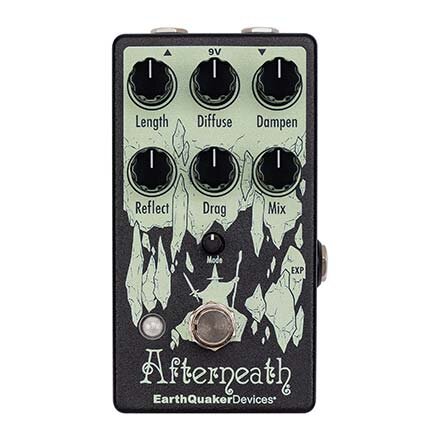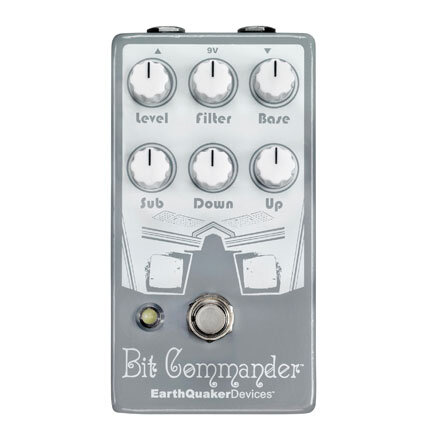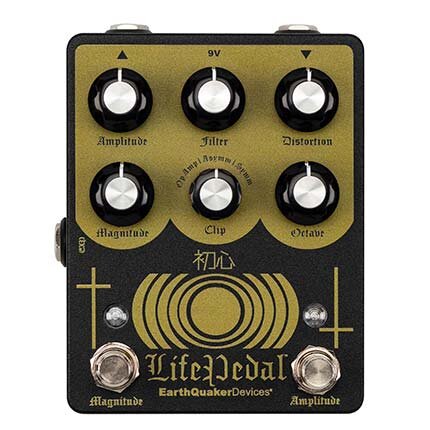Chris Chaney : Everywhere at Once
Jon D’Auria
Rock star, first-call session player, A-list sideman, songwriting ace, television and movie scorer, tour-hopping road warrior, clinician, mentor, musical director, and bandleader. These are just a handful of the many titles Chris Chaney has earned throughout his 26-year career as a bassist. At 50, he is easily one of the busiest and most in-demand players at the greatest of heights, with a drive and work ethic matched by his tasteful playing and ability to adapt to any situation. It’s no surprise that he was one of the few musicians who remained busy throughout the 2020 lockdown; cutting an album with guitar god Joe Satriani, performing with pop star Miley Cyrus, recording with Ozzy Osbourne, and jumping from television and movie scoring projects to album sessions daily.
Being sought out is nothing new for Chaney, who received his first big break in 1995 playing with a then-unknown artist named Alanis Morissette, who was about to release an album called Jagged Little Pill. It turns out that was a good move, as both the record and Alanis’ fame skyrocketed to unimaginable levels, and Chaney’s career hasn’t slowed down since. From there, his credits quickly grew and spanned genres as he worked with artists like Celine Dion, Slash, Glen Campbell, Joe Cocker, Cher, Shakira, Rob Zombie, Bryan Adams, Josh Groban, Meatloaf, Carly Simon, and way too many others to name here. In 2002 he became a member of Jane’s Addiction, a role he still holds today and is eager to resume once touring is back in action.
On top of his steady arena-sized touring and reign as a studio bassist, Chaney fell into the world of film and television scoring in 1998. Thanks to his mastery of many playing techniques and superb sight reading skills, his work is featured on countless TV shows and blockbuster movies like 300, The Hangover trilogy, Watchmen, The 40-Year-Old Virgin, Get Him to The Greek, and the upcoming Wicked, to name a few.
To cover that much ground stylistically, you’d assume that Chaney’s gear collection is something to behold, and you’d be right. Collecting everything from mint condition ‘50s and ‘60s Fender basses to the latest modern creations from Nordstrand, Serek, and Wilcock, it’s hard to catalog the arsenal he’s acquired over the years. And naturally, to cop the vast array of studio sounds he needs, his pedal collection grows constantly. Among his go-to’s are the EarthQuaker Devices Pyramids, Bit Commander, Afterneath, and Sunn O))) Life Pedal, the latter of which he claims is “bowel-rattling overdrive and bass distortion at its finest.”
In between filming with Miley, studio sessions with Ozzy, and jamming with his circle of drummer friends, Taylor Hawkins, Josh Freese, and Chad Smith, Chaney is currently working in his home studio in Los Angeles. We caught up with him there as he navigates both his chaotic schedule and the difficult decisions of which gear to use for his next sessions.
Unlike a lot of musicians, you were constantly working through the 2020 lockdown. What were some notable sessions you took on?
It was a lot, luckily. I did a bunch of different albums and studio work throughout the year and got to focus on doing some movies and TV shows on top of those. I recently played on a couple of tracks for Ozzy Osbourne’s upcoming record, one with Chad Smith [Red Hot Chili Peppers] and Andrew Watt, and one with Taylor Hawkins [Foo Fighters]. I jumped in with Miley Cyrus for some shows and livestreams, and we have an SNL performance coming up (Season 46 Episode 19, aired May 8, 2021). The most recent thing I’ve been doing is playing on the score for a series on Disney Plus called The Mysterious Benedict Society, which was a series of books that I used to read to my kids. So that’s pretty cool.
As in-demand as you are, you must have to turn a lot of projects down nowadays.
I’ve definitely gotten to be a lot more selective over the years. I don’t want to sound cocky, but I’m not saying yes to things like I used to. I used to say yes to everything. It was a weird insecurity or fear that if I didn’t say yes, then the other guy was going to get the call, and then they’d be higher up on the list than me. Even when I was working all the time, I would do every gig I was offered. But for the last 4 or 5 years, I’ve been really selective in the projects I take on. Music is not a competition, but I used to be really competitive, and I’d follow the feast or famine mentality. I don’t think it’s healthy to do that, but then again, when you’re coming up in the industry, you have to pay next month’s rent too.
How do you decide on which gigs to take now?
I have some simple rules for taking on a gig. You have to ask yourself: is the money good? Are the people good? And is the music good? If all of those are in place, then it’s the ultimate gig. If one of them isn’t there, I’ll usually still do it unless the people are dicks. But if the people are cool and the music is cool, then I’ll probably still do it. If the people are cool and the bread is good, and the music sucks, then I might do it just because it’s a good hang, and we can laugh about it. But these days it has to be good people and the music has to be cool. I don’t want to do something if I’m not having fun.
It looked like you had fun performing with Miley Cyrus recently at the 2021 NCAA Final Four tournament. How did she decide to primarily do covers for that?
Miley is an amazing artist, and she wanted to pay homage to some of her biggest influences. She can really nail that stuff. We peppered in some of her big songs too, but otherwise, it was all classic covers. She really is an incredible performer. I was telling Taylor [Hawkins] that she reminds me of when we were playing with Alanis Morissette back in the ’90s because she has the same kind of fire and passion. She nails the fuck out of it, man. I’ve never heard her make a noticeable mistake. She’s vocally powerful too. I’ve been around a lot of singers, and she’s right up there at the top. And the fact that she’s 28 and she chose a bunch of seasoned veterans to play in her band tells you a lot about her.
Another project you recently did was Joe Satriani’s new album Shapeshifting. What was that like?
I had done a record with Joe about eight years ago called Unstoppable Momentum, and it was a different band with Vinnie Colaiuta on drums and Mike Keneally on keyboards. This latest record was done with producer Jim Scott at his studio, PLYRZ, which is a whole world of its own. We went up there for a week and a half straight. We took our time and did a couple of songs a day. Kenny Aronoff played drums, and we did it as a trio, so it has such a great feel to it. It was such a fun record to make with Joe, and he even had me play baritone guitar on a track.
Wow, so you’ve actually played guitar on a Satriani record? That’s a big feather in your cap.
Yeah, it was nuts. I copped his parts and then told him he has to play it because I suck on guitar. He wanted me to double my bass line and do it muted on the guitar, so I bit the bullet and did it.
How did you adapt to recording during the lockdown? Did you primarily work from your home studio?
I did quite a few sessions over in Hollywood at United Recording and EastWest, but the distancing rules applied, and I would get tested for all of them. I’ve probably had my nose swabbed close to 200 times in the last year. But I did do a whole lot of work from my home studio in LA. Early into the pandemic, my wife and I got a house in Palm Springs. We wanted to get a little more insulated between the pandemic and all of the riots that were happening right outside of our home in LA. Our Palm Springs house has two master bedrooms, and my wife was gracious enough to let me turn one of them into a full studio, so I’ve done a bunch of sessions out there too.
What are the keys to engineering and recording your own bass tracks?
I’ve been lucky enough to work with amazing engineers and producers, so I’ve picked enough of it up on my own to somewhat know what I’m doing. And I always ask a ton of questions. I use an Aguilar 4x10 cabinet and 1x12, and I have an Ampeg B-15 that I use all the time. It depends on what I’m doing, really. For some of the TV and film work, the ranges are a little bit lower, so the B-15 isn’t always ideal even though it’s the most buttery tone ever. Then I go into a BAE 1073 and touch it with a Universal Audio LA2A, and then I’ve been using a couple DI’s. The Tone Craft is one of them; then there’s the Broughton Audio P15 that Justin Meldal-Johnsen [Beck, NIN] turned me onto that’s made by a guy up in Canada. Then I have the Zod Audio ID DI out of Nashville. I use my Noble DI for almost everything too. I’ll touch it with OverStayer’s saturator and distortion called the M-A-S. I’m not one of those guys who digs in and plays super hard, so I compress myself with my own playing pretty well.
You’re known in the bass world as one of the greats of movie and television scoring. How did you first get into them?
The first one I actually did was a song on a soundtrack with Alanis for a movie called City of Angels [1998], and it played during the end credits, which was pretty awesome. A great score can make a movie, and a shitty score can ruin a great movie. You can easily dismantle a genius director’s work with terrible music. I’ve always had that fascination and it was something I had wanted to do for a long time. Rob Cavallo produced that first song with Alanis and I started doing some sessions for him after that because we hit it off and worked well together. Delivering the goods musically is the prerequisite, but building relationships is the other half. He had a movie after that called The Waterboy [1998] with Adam Sandler and it was the first actual scoring I had done. Then I met Scott Humphrey through him and he had a studio called The Chop Shop and I started working with him a lot. Then one opportunity led to another and I started doing a bunch of scores and soundtracks. Then, through Lyle Workman I met Christophe Beck and that changed it for me. I started getting into the world of some of the bigger contractors, which led to big gigs that started coming steadily.
Aside from building those relationships, why do you think you kept getting those gigs?
A lot of it came down to my reading chops. You have to be able to deliver good tone on the fly and play the parts. But not everyone can read a pick part that needs to be played a specific way. Reading dynamics and rests and doing it all to a click while nailing it on the first take is what gets you those gigs.
What’s your process for taking on scores?
I have a checklist that I made for myself to keep from getting in binds on the fly. It is finding the highest note, the lowest note, and the tempo changes. The first thing I do when I get on one of those sessions is I scan through the 20 or 30 charts and take notes on them. Then I discern where I’m going to play on the neck depending on what kind of tone it needs. Kind of like how Paul McCartney would play higher up to get a fatter, beefier tone versus playing it down the neck where Geddy Lee would play “YYZ.” I love the challenge of it because it’s a different mental landscape than improvising over jazz or playing over a singer’s music. I’ve always prided myself on being adaptable.
How do you decide which pedals to bring to each gig?
I have a specific pedalboard for Jane’s Addiction because I need to get the exact sounds required for that music. But in general, I have one of my kid’s JanSport rollaway backpacks that I throw a bunch of mainstay pedals into for studio sessions and scoring gigs because you really just never know what you’re going to need. A majority of the time, I use just my bass into a DI with a little bit of grit on the amp. Especially if it’s two tracks, or they’ll add stuff after the fact with plug-ins. I’m not above utilizing all of the options. I definitely throw some Earthquaker Devices pedals in there too.
Which ones have you been using lately?
I love the Pyramids. It’s just incredible. I use their Bit Commander a lot and their Afterneath. Those are on a new record I’m working on, and I gave them to the guitarist and he’s been using them a lot on the tracks too. Another major one I use is the Sunn O))) Life Pedal, which I first learned about from a keyboardist that I was working with on the movie Trolls. His name is Zac Rae [Death Cab For Cutie] and he’s a phenomenal player. He told me that he had the original pedal and EarthQuaker was doing the exact schematic replica, so I got one. The thing just has insane low end. Like, shit your pants kind of low end. It’s bowel-rattling overdrive and bass distortion at its finest. You want a Meyers Sound PA system just for that pedal.
What have you been working on in your personal practice lately?
I always said that by the time I’m 50, I would be able to play Jaco Pastorius’ version of “Donna Lee,” so I’ve been working on that. I can play it from the beginning to the end at tempo, but there are a couple of parts that I’m still perfecting. That ending passage before the head out I can’t do at tempo yet, and the 8th note triplet at tempo is still challenging. I want to be able to execute it in time as if Don Alias was playing percussion next to me. I guess I’ll be twice as old as Jaco. He did it when he was like 25 [laughs].
What’s coming up next for you?
There’s some Jane’s Addiction stuff coming together for the fall (hopefully). A bunch of sessions are coming up. I’m doing a bass seminar that will air in Japan, and I have some performances I’m playing on with Miley. I have a project that I’m so excited about but can’t talk about yet, but it’s some of the proudest moments of my bass playing ever. I can’t wait to unveil that when the time comes. I co-wrote all of the music and I really get to step out on it. Other than that, I’m going to help my kids navigate this crazy 2021 and try to enjoy myself.
Jon D'Auria has been in music journalism for over 16 years as an editor, columnist, staff writer, photographer, web editor, and gear editor. He has conducted over 400 interviews and has been lucky enough to connect with most of his bass heroes. When he's not writing, he keeps busy gigging, running, reading, hanging out with his two huskies, and attempting to teach his toddler slap bass.









